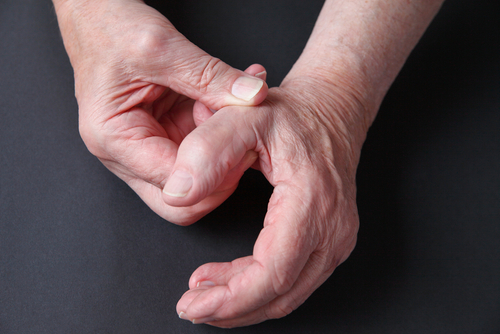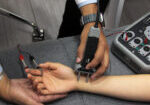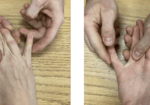Changes in ROM of the MCP after Trapeziometacarpal Arthrodesis
Filed under Reviews
Rapid Review: Changes in ROM of the MCP after Trapeziometacarpal Arthrodesis

Hayashi, M., Kato, H., Komatsu, M., Yamazaki, H., Uchiyama, S., & Takahashi, J. (2021). Changes in the Functional Range of Motion of the Thumb Metacarpophalangeal Joint After Trapeziometacarpal Arthrodesis for Patients With Advanced Trapeziometacarpal Osteoarthritis. The Journal of hand surgery, S0363-5023(21)00613-4. Advance online publication. https://doi.org/10.1016/j.jhsa.2021.09.018.
The Skinny:
Several published studies have advocated for simultaneous procedures for thumb cmc arthritis. The procedures include the Trapeziometacarpal (TMC) arthrodesis and correction of the hyperextension deformity of the MCP joint. This study looked to determine if a procedure to the MCP joint was necessary to correct the hyperextension of the joint by determining changes in the range of motion of the thumb MCP Arthrodesis before and after TMC arthrodesis. The authors also looked to determine functional ROMs of MCP joints (MCP ROM) before and after TMC arthrodesis.
In the Weeds
A total of 15 thumbs in 12 patients were TMC osteoarthritis underwent a TMC arthrodesis between 2010 and 2015. Ten thumbs were examined using preoperative radiographic measurements including the extension of the MCP joint while the thumb was resting. All thumbs were symptomatic stage III Eaton classification for TMC osteoarthritis and were treated with TMC arthrodesis. Measurements were repeated post-operatively. The patient’s average age was 66 years of age, and there were 3 males and 6 females enrolled in the study. Post-operative measurements were taken at a minimum of 10 months and a maximum of 28 months after surgery.
Range of motion was evaluated during the following ADL tasks: holding a glass, opening a bottle lid, opening and closing a plastic cap, twisting a towel, grasping a steering wheel, buttoning a shirt, pulling a note out of a wallet, clipping fingernails, typing a keyboard and washing a face.
Bringing it Home
The MCP’s average functional range of motion in the flexion plane increased from 26 to 38 degrees, and the average extension of the MCP joint decreased from 16 to 5 degrees hyperextension. There were no significant changes in the total arc of motion. ADL tasks before and after the arthrodesis required half of the active range of motion of the MCP joint. The study results suggest a simultaneous procedure to correct the hyperextension deformity of the MCP joint might be unnecessary when performing TMC arthrodesis.
Rating: 4/5
The study had a few limitations. The number of patients in the study was small, making it difficult to draw conclusions from the study. There was no control group in the study for comparison. The study could potentially replicated on a larger scale to draw more affirmative conclusions.
More To Read
Do you know the difference between an Electromyography (EMG) and a Nerve Conduction Velocity (NCV) Study?
Do you know the difference between EMG and NCV (an Electromyography and a Nerve Conduction Velocity Study? The term nerve test is usually a broad term that typically indicates both an Electromyography (EMG) and a Nerve Conduction Velocity (NCV) study (EMG vs NCV). An EMG looks at the electrical signals your muscle makes when at…
Read MoreWhat? I just received an order for suture removal…
How many of us have practiced suture removal in occupational or physical therapy school?? NOT I!! Often, hand surgeons will ask the therapist to remove sutures and sometimes the order will even say “remove sutures when ready” SO NOW WHAT? How to remove continuous sutures? First, we can cover the basics of sutures! There are…
Read MoreHand Therapy Article Review: The Radial Synergy Test, An Aid to Diagnose de Quervain’s Tenosynovitis
Chihua, L., Langford, P.N., Sullivan, G.E., Langford, M.A., Hogan, C.J., & Ruland, R.T. (2021) The radial synergy test: an aid to diagnose de Quervain’s tenosynovitis. HAND. epub ahead of print;1-6. doi: 10.1177/15589447211057297 Rapid Review By: Case Peters The Skinny: de Quervain’s tenosynovitis is a common pathology that involves swelling and thickening of the tendon sheaths…
Read More3 Household Objects for 9 different Hand Therapy Activities
Do you struggle to develop new treatment ideas or even ideas for your virtual hand therapy visits? Thinking of unique ways to use objects your clients have in their homes can be half the battle. This blog post presents 3 different ways to use 3 everyday items. Item number 1: A tennis ball (hand therapy…
Read MoreSign-up to Get Updates Straight to Your Inbox!
Sign up with us and we will send you regular blog posts on everything hand therapy, notices every time we upload new videos and tutorials, along with handout, protocols, and other useful information.






